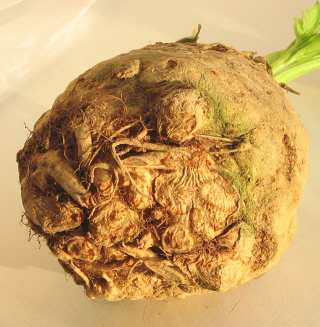 In an attempt not to get into the same-soups rut I created last year, I decided to make Double Celery Soup, which I hadn’t made for years and recalled being quite enthusiastic about. I stopped at the store when I was in transit from one spot to another and bought a celery root (or celeriac), which an ugly, brown, gnarled thing about the size of a large grapefruit with some celery-looking greenery coming out the top.
In an attempt not to get into the same-soups rut I created last year, I decided to make Double Celery Soup, which I hadn’t made for years and recalled being quite enthusiastic about. I stopped at the store when I was in transit from one spot to another and bought a celery root (or celeriac), which an ugly, brown, gnarled thing about the size of a large grapefruit with some celery-looking greenery coming out the top.
When I got home I realized that I didn’t have broth in the freezer nor any of the suggested herbs. I plunged ahead with the soup, from Patricia Wells’ Bistro Cooking. It turned out just OK—the broth was inadequate and I cut the vegetables too large for who-knows-what reason—but the story wasn’t over.
After eating the marginally acceptable soup for a couple of days, I decided to put my amazing leftover talents and my new immersion blender to use. The result: a completely satisfying soup! Yea.
The original soup
Here’s how it’s done, starting with the original soup, including the original instructions in case you want to make a proper Double Celery Soup.
Double Celery Soup
- 1 medium celery root (about 1 pound), peeled and diced
- 10 celery ribs, cubed
- 3 leeks, trimmed, well rinsed and cut into thin rounds Mine: 1 medium onion, chopped
- Bouquet garni: 1 large sprig of thyme, 3 imported bay leaves, several sprigs of parsley, tied with a string Mine: 1/4 teaspoon dried thyme leaves, 1 extra-large fresh bay leaf, zero parsley
- 2 quarts chicken stock, preferably homemade Mine: 1 quart commercial organic chicken broth plus 1 quart water
- Salt and freshly ground pepper
- A handful of chopped fresh herbs for garnish: including chervil, chives and flat-leaf parsley Mine: none
- In a large saucepan, combine the celery root, celery, leeks and bouquet garni.
- Add the stock, and season gently with salt and pepper. Bring to a simmer over medium high heat. Simmer until the vegetables are soft, about 25 minutes. Adjust the seasonings.
- Pour into warmed shallow soup bowls. Sprinkle with the chopped herbs and serve immediately. Makes 6-8 servings.
The variation
This was so easy, it’s a shame I didn’t think of it sooner!
Step one: Puree soup with immersion blender. This step alone made an improvement over the original soup as I’d made it with overlarge chunks of celery root and celery. Heat soup to a simmer. I probably could have added just a pat of butter or dribble of olive oil and been satisfied at this stage. But I went a step further.
Step two: Chop a stalk of broccoli medium-fine to add the color that the fresh herbs would have provided. I also chopped a handful of leftover chicken. I added both to the simmering, pureed soup and let simmer 6 minutes, enough to heat the chicken through and tenderize the broccoli.
It still isn’t exactly pretty, but it smell great and looks more appealing than large chunks floating around in thin broth:
The lesson: When at first you don’t succeed, change it up a bit; you just might love the results. What do you have to lose?




Joanne // Jan 19, 2009 at 12:25 pm
I love pureed soup, it always seems to improve, in my opinion. My husband is a lover of clear soups, but I just can’t accommodate him most of the time! I also think bits of fat and other flavor helps…especially when other ingredients are thin on the ground. My “booster” for vegetarian/Vegan soups usually include a dash of balsamic/sherry/malt/cider vinegar (it’s flexible) and maple syrup. Really heightens flavors. I find that a little meat goes a long way in a soup; definitely useful for stretching one’s budget!
Janet Majure // Jan 21, 2009 at 3:09 pm
I like soups pureed or clear, although I don’t tend to make much in the cream soup category. I agree vinegar often is a nice touch. I’ve never tried maple syrup. I’ll have to keep that in mind.